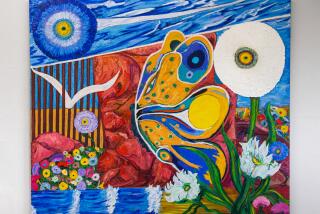Rare Glimpse of Australian Aborigine Art : Another Culture, Time Also On Display in CSUN Exhibit
- Share via
In Australian aboriginal culture, dreamtime refers to the mythical twilight before creation when man’s totemic ancestors roamed the barren land, breathing life into rivers, mountains, animals and, eventually, man.
Young men learn these tales at initiation, chanting elaborate song cycles while they construct sand paintings to illustrate the myths. The creation lore has been passed down in this manner for thousands of years.
“Dreamtime: Art of the Australian Aborigine,” which opens Monday at Cal State Northridge’s Main Gallery and Anthropology Museum, offers a glimpse of aboriginal culture, whose art has been captured on canvas only since 1971.
Most of the 80 paintings--on canvas and bark--plus the tools, shields and ceremonial objects, were loaned by the Kelton Foundation, which, through Los Angeles businessman Richard Kelton, owns one of the world’s largest collections of Australian aboriginal art.
“You don’t have to know the cultural content to appreciate it. It’s pretty just on the surface,” Kelton said of the abstract, pointillistic paintings. Painted primarily in the dusky earth tones of the Australian desert, the paintings also evoke the desert’s huge expanses: A panoramic canvas by Clifford Possum Tjapaltjarri is 12 feet high and 8 feet across.
Experts say the paintings serve as topographical desert maps that delineate trails and rivers and provide the nomadic desert tribes with invaluable geographic records. But the abstract shapes also symbolize the ancestors, campsites and animal tracks of Australian aboriginal legend.
‘Different Layers’
“These are powerful paintings,” said Louise Lewis, CSUN gallery director. “When I first looked at it, it was from the Western point of view, an appreciation of the dots, the composition, the visuals and the color. But there’s all these different layers of the dreamtime, ancestors and topography.”
The CSUN show marks only the second time that Australian aboriginal art has been exhibited in Southern California. The Pacific Asia Museum in Pasadena mounted the first show in 1980-81. Pacific Asia loaned some pieces for this month’s CSUN show, as did the UCLA Museum of Cultural History.
Lewis says aboriginal art is riding the growing wave of American fascination with all things Australian--from film and music to wine coolers and movies.
“It’s breaking into the international art world. There’s an increased interest as collections such as this are placed before the public,” said Kent Tobey, Pacific Asia Museum curator.
Lewis draws a parallel between Australian desert painting and the kachina dolls crafted by American Hopi and Zuni Indians.
‘New Frontier’
Aboriginal art “is the new frontier,” said Lewis. “Just like our American Indians have finally gotten the recognition they deserve, so are the aboriginals beginning to be recognized.”
The irony implicit in all this is that the growing demand for aboriginal art has created a cottage industry of painters who produce works for sale instead of the traditional rituals, Kelton says.
“It’s moving away from its cultural origins,” said Kelton, who added that he has found it difficult lately to acquire new paintings because of the art’s increased popularity inside Australia.
A 30-foot-long canvas by Michael Nelson Tjakamarra called “Possum Dreaming” is to hang amid the glitter and glass of the Sydney Opera House. Another work has been commissioned for World Expo ’88 in Brisbane. Yet another dreamtime painting is reproduced in mosaic form at the new Parliament building in Canberra.
Meanwhile, an exhibit of aboriginal art organized by the Australian government is touring the world and is tentatively scheduled to come to Los Angeles at the end of the year. In addition, the Caz gallery, which specializes in Australian art, is expected to open this week in West Hollywood.
“It’s an exciting time. A number of artists are making major names for themselves and being collected,” said Doran Ross, associate director of the UCLA Museum of Cultural History.
Australian aboriginal culture dates back 40,000 years. Dreamtime art is thought to have been handed down through ceremonial ritual for about 12,000 years, but there was no permanent record of it until 1971, when a young teacher named Geoff Bardon came to central Australia to teach arts and crafts. He started a mural project and encouraged the students to draw designs similar to those found in sand paintings. The patterns originally constructed on the open desert with ocher, charcoal, white gypsum paste and bird down were now captured on canvas with modern acrylics.
“Until recently, these paintings were just known by a few people,” Lewis said. But she added that word of mouth has already brought some local artists over to the university to view the cache.
“They say, ‘Oh my God!’ They just freak.
“That’s why I want people to see this.”
“Dreamtime: Art of the Australian Aborigine” runs through Dec. 2 at CSUN’s Main Gallery and its Anthropology Museum. The Main Gallery is open from noon to 4 p.m. Mondays and 10 a.m. to 4 p.m. Tuesdays through Fridays. The Anthropology Museum is open from 9 a.m. to 4 p.m. Mondays through Fridays. For information, call (818) 885-2226.
More to Read
The biggest entertainment stories
Get our big stories about Hollywood, film, television, music, arts, culture and more right in your inbox as soon as they publish.
You may occasionally receive promotional content from the Los Angeles Times.










